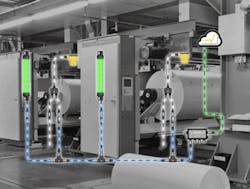Product News: Banner IIoT product line Snap Signal
Banner Engineering's Snap Signal example
Banner Engineering introduced a new IIoT product line, Snap Signal, that promises to capture data from nearly any industrial machine’s device and converts it to a common protocol, enabling an upgrade to Industry 4.0 and higher productivity.
Snap Signal products can be used to build a brand-agnostic IIoT platform that’s composed of modular hardware and software, per Banner. The system can capture and convert machine signals and protocols, such as Modbus, Analog, Discrete, Serial, or IO-Link, among others.
A Snap Signal platform can capture both condition- and process-monitoring data from existing devices such as sensors, motor controllers, and lights by using a splitter connection to monitor the signals. When used in this way it’s called an “overlay network,” meaning signals are captured without having to disturb the existing control infrastructure, reducing both the time to deploy it, and overall risk, according to its maker.
Data can be sent to various locations, including a cloud dashboard or SCADA system, which enables remote monitoring, or to other PLCs and HMIs. The solution is highly scalable and allows facilities to pilot an IIoT project by monitoring just one sensing point. This approach of starting small helps manage costs and prove future ROI with real data from the pilot. The Snap Signal portfolio includes, signal converters, wireless networking, IO-Link masters and hubs, and an industrial controller, all of which use industry-standard M12 connectors for simple installation. An optional cloud data platform, Banner Cloud Data Services, is available for users who do not have a dashboard solution already in place, they note.
“Manufacturers are seeking a move to IIoT to increase productivity,” said Banner Director of Global Business Development Luke Karnas. “They need data on the process improvements they’re making. Instead of having workers walking around writing numbers on clipboards, Snap Signal sends data from machines 24/7. It can be implemented at any point along your data flow chain, and it can take the complexity out of a move to Industry 4.0.”




